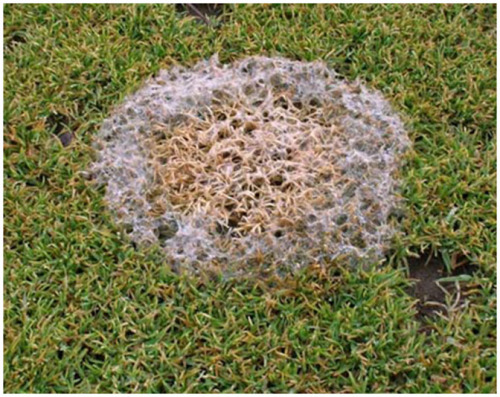With the extended snow cover we have had for the past month, I thought it would be appropriate for our first newsletter of 2021 to address snow mold disease. We’ll talk about what it is, identification, prevention and treatment.
Understand & Identify Snow Mold Disease

There are two different types of snow mold disease, but we will be discussing the variety most common to us in this area, pink snow mold. A fungal disease which thrives in damp, cool conditions, pink snow mold is easy to identify. It presents itself in well-defined circular patches in the turf. During wetter weather, it can be seen with fluffy white-pink growth as the spores grow on grass blades.
It is most common to see this disease in the spring as the turf comes out of winter dormancy, but it can present itself in the fall as well. Extended snow cover is not necessary for this disease to take hold, but the insulated, matted-down turf under piled snow will make it more likely.
Snow Mold Disease Prevention
The easiest way to prevent the occurrence of snow mold disease in your lawn is to prevent matted-down turf and lawn debris.
As I had mentioned in my last newsletter in 2020, it is wise to lower your mowing height to between 2½-3” for your final cut of the year. Taller grass greatly increases your chance of seeing snow mold disease the following spring. Kentucky bluegrass and Perennial rye-grass are both especially susceptible to this disease when left at a height of more than 3” over winter.
Matting of cut grass and other materials can create disease conditions. After your last mow of the season, be sure to remove or thin out heavy areas of leaf or grass debris on your lawn before the first snow.
What to do if you see Snow Mold in your lawn
The easiest and least expensive option is to scratch the matted areas with a rake or your hand to break up the matting that has taken place. This will allow the grass plants to breath, and more often than not these areas will fully recover.
If this disease is a common occurrence for your lawn year after year, it may be worth considering a fungicide treatment to control it. Fungicide treatments are costly, and rarely needed. However, if other prevention and treatment options fail, you should consider this option.
Fungicide treatments should be made in the late fall before the first snowfall. This treatment will protect the lawn against the occurrence of snow mold disease. Please be sure to follow the manufacturer’s directions; improper application or use of the wrong fungicide can damage to your grass. We would be happy to help in applying this for you as your turf-grass professional!
You can find more detailed information about snow mold disease from this Purdue Extension article.
Be sure to keep an eye on your lawn as it comes out of dormancy. If you see the signs of snow mold disease, be sure to lightly scratch those areas to break up the matting while not pulling the grass up out of the ground.
General maintenance for healthy lawns helps with prevention and recovery, so be sure to take care of your grass throughout the season so it will be as healthy as possible. Get Green will take care of the nutrients your lawn will need to aid in health and recovery.
Your lawn will thank you for it!
